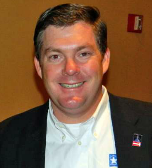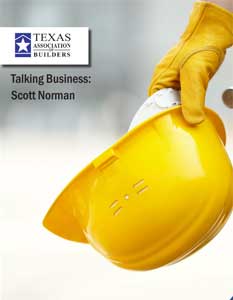Scott Norman – 30 minutes with the executive director of the Texas Association of Builders
BUSINESS VIEW: When the association got started back in the 40s, what niche was there? What was the purpose of getting the association started?
SCOTT NORMAN:  Well, here’s a brief history. Post World War II, the national association and lots of local associations formed, because home building was up due to returned soldiers and families and all of that. There was a post-war housing boom. Builders came together like other trade associations to work on common issues and to find common solutions for problems and challenges faced by the industry. So, we are a 501c6 business league or trade organization – it’s what the IRS defines us as. We represent homebuilders, remodelers, developers, and in terms of associate members, we have around 10,000 around the state. But you are correct, we formed in 1946. Our state association and some of our local associations formed around the same time. Many formed later, obviously, but we are one of 28 local homebuilder associations around the state and we’re affiliated with the National Association of Home-builders in Washington D.C.
Well, here’s a brief history. Post World War II, the national association and lots of local associations formed, because home building was up due to returned soldiers and families and all of that. There was a post-war housing boom. Builders came together like other trade associations to work on common issues and to find common solutions for problems and challenges faced by the industry. So, we are a 501c6 business league or trade organization – it’s what the IRS defines us as. We represent homebuilders, remodelers, developers, and in terms of associate members, we have around 10,000 around the state. But you are correct, we formed in 1946. Our state association and some of our local associations formed around the same time. Many formed later, obviously, but we are one of 28 local homebuilder associations around the state and we’re affiliated with the National Association of Home-builders in Washington D.C.
So, it’s a federation you join at the local level – some of the local home-builders associations are the Greater Austin Builders Association, the Dallas Builders Association, and what have you, and of course, your dues go towards the state association, which goes to national, and just as there’s three levels of membership, there’s three focuses. Our local HBA’s focus on local matters – city, county, a lot of education, social events, charity – those kinds of activities. On the state level, we primarily exist for state capital, dealing with state agencies, issues of statewide concern, and similarly, the HBA in DC handles federal matters. So, it’s what we do and where we came from and we’ve been doing it a long time – it’s very consensus driven. Obviously, we are a large organization, with 10,000 companies and agencies represented by 450-470,000 jobs and 30 something billion dollars of the economy. I don’t know what our latest number is, but it’s north of 30 billion dollars of the state’s economy that’s for developing and remodeling and construction industries.
BUSINESS VIEW: How much has that role evolved? Obviously times are different now than they were in 1946 – are you still essentially serving the same role and doing the same kinds of things? Or is it drastically different than it was back then?
NORMAN: No, I think the means of communication, the channels of communication, the involvement, whether that be through social media or that sort of thing – some of that has changed, you know, you don’t have as many mail-outs or newsletters through the snail mail and that sort of things. But, I think a lot of the issues have remained similar. We’ve gone back and looked at some of our archives and some of the issues they were dealing with in the 40’s and 50’s that affected housing affordability, transportation, future water supply – those sorts of things, it’s a lot of the same things we’re dealing with today. I’m dealing with this legislative session over at the capital, how are we going to fund our state’s highway system, what are we going to do to make sure we have an adequate water supply moving forward.
It’s a lot of the same issues – education, workforce issues, how we are going to handle an aging workforce and how are we going to replace these workers in the industry. And then, of course, issues specific to us like different regulatory matters, dealing with how cities and counties regulate our industry, dealing with the various effective trades and license trades that work on our jobsite that maybe are licensed by various state agencies. We engage in litigation occasionally on issues concerned with our industry and so, I think a lot of the issues are the same, even some of the ways we go about them by reaching consensus and working on issues and engaging in old-fashioned shoe leather, and reaching out to decision makers, and explaining our case, and those sorts of things – lobbying, if you will. A lot of those things are the same, but you just have to evolve. It’s all drive by involved volunteers and we’ve had a good professional staff for a long time. We try pretty hard, but it’s interesting. It’s engaged members that carry the weight, you know the old 80-20 rule for the industry, I suppose.
BUSINESS VIEW: You mentioned the membership number around 10,000 – has that been fairly stable? Or has that changed one way or the other lately?
NORMAN: No, it’s been fairly stable. We got to over 14,000 in the year 2000. I don’t have to refresh your memory on what was happening with the housing boom then. That was our all-time peak, but we fell off. Our membership fell off a good bit. Housing starts in Texas fell off two-thirds, like they did all over the country, but I think Texas, I tell people, was the least sick of all of the patients, of the states around the country, because even though our housing starts plummeted and our membership plummeted and everything else, it was a lot worse in many other areas of the country.
But, our membership dropped down from a peak of 14,000 to about 8,000, but we’re back at around 10,000 right now, which is curiously about where we were in the early 2000’s. So a lot of companies and individuals in companies in the industry in ’06-’07 crashed and there was some consolidation and such, so it’s probably a smaller pool today. I say probably, but I know it is than what was out there in the mid 2000’s, but some would argue that everything in the housing industry was not too great then.
BUSINESS VIEW: Out of the percentage of people that could be members, do you feel that you have a pretty good penetration rate out of those who could be members?
NORMAN: We do. We guesstimate that somewhere north of 90 percent of all homes built in the state are built by our members. We feel pretty confident about that. Obviously, we have all of the large production builders, who make up a large number of the starts. And then we have very strong market penetration and most of our membership penetration is in most of our local communities. And so, there is always more folks that can be members, especially there’s always more builders and remodelers that can be members, but probably even more so, there’s always more workers and associate-affiliated members, because our membership is not only builders and remodelers, it’s suppliers and bankers, and vendors, and the companies and people that supply things and services to our industry.
BUSINESS VIEW: Let me make sure I have this right. Does anyone just straightaway join the state association? They’re all joining locally and they then are automatically members at the state level and national level?
NORMAN: 99 percent of them are joining at the local level – that is correct.
BUSINESS VIEW: Are you competing with any other associations for the same pool of members? You said when they’re joining locally that they’re automatically a member of state and national, so obviously that’s not a case, but are you competing for the same pool of people with other groups?
NORMAN: Not really. There are a couple of other local homebuilder clubs around the state, but we are the only statewide homebuilder trade association and almost all of our local area ones are the only local homebuilders. So, not directly, but there are other real estate related organizations, but homebuilders specifically, we are pretty much the only game in town.
BUSINESS VIEW: For the typical member, what’s their reason for joining? What benefits or services are they particularly looking for?
NORMAN:Well, if someone is an old lobbyist and does advocacy on the state level, I would love if they were all joining for government relations, but that is not at the top of the heap. Most members join, and it depends on whether they’re a builder or if they’re someone that we call an associate member, which is not a builder – if they’re a builder, they join for educational purposes, to network with their peers, learn from their peers, and give back to the industry, and, as part of that, to try to affect change for the benefit of their industry. That’s kind’ve what we give back – we do survey. For associate members, same thing, but as you can imagine, the networking is more business-driven, trying to meet builders, meet remodelers, meet people they can do business with – networking as well, but it’s business relationships that are really why most associate members originally join, but then they learn there’s other things they can do and the one thing about our local associations over state, whatever floats your boat so to speak, you can find it – whether it be charitable activities, education, political involvement, government relations, there’s committees to do those sorts of things.
BUSINESS VIEW: I guess the reasons why people join a group don’t always match or run in tandem with the values of the group assumes to provide. Is there one particular service that the group plants its flag in the ground and says this is what we do particularly well – is it legislative issues, networking, providing education, what do you guys try to sell yourself with?
NORMAN: On the state level, and again, most join on the local level, so most aren’t joining first and foremost because of what we’re doing on the state level. Although, there’s obviously benefits to members and to non-members as well that are in the industry. But, I would say on the state level, obviously, our reason for being is for advocacy, dealing with the state legislature and agencies, and those sorts of things. That is our number one mission. Other things that we do include that we have a Builders Foundation that does charitable and education work, we have a Sunbelt Builders show, which is a large trade show that we have every summer around the state. And so, we have many other activities that occur, but obviously our first on the state level is advocacy.
BUSINESS VIEW: Are there any common issues that a good cross-section of the membership is talking about these days? Is there something specific that they’re worried about or that they’re talking to you about?
NORMAN: Well, I think one thing that weaves its way through everything we do at the capital and other places is to try to remind our decision makers, as well as they do in Washington DC and that they do at the local level in cities, counties, what have you, is try to remind decision makers or officials or whoever they may be of the impact their decisions have on housing affordability. National Association of Homebuilders has conducted numerous studies and established that 25 percent of the cost of a new home can be attributed to government regulations on a local, state, and national level. And so, that obviously dramatically impacts homebuyers, especially as you go down market, or down income levels, it affects them more so. So, we try to remind legislators and decision makers of that, because obviously, the more expensive homes are, the less homes we can sell as an industry, but also the less folks that can afford to buy them. It impairs home ownership, which we think is a good thing and most people concede is a good thing.
BUSINESS VIEW: What ways have you had the most success in engaging your membership? Is it the events? The publications? The online stuff? What sorts of things have resonated the most?
NORMAN: I think it’s all of the above. What we’ve learned with these new stages of media is that different people get their information in different ways, so you just have to put it out there as many ways as you can. It’s harder these days to get people’s attention. We have a magazine; we have a web presence on social media. We have meetings three times a year, we have board meetings, the Sunbelt Builders show – those are all things we do on the state level. We have our rally days, our big capital day, where we will have hopefully close to 1,000 of our members come to the state capital from all over the state for one day and go and meet with their elected officials and gather and all of those sorts of things.
So, there’s a number of things we do on a state level to engage people. At our board meetings we have three times a year, we have committee meetings held in conjunction – we have committees for various things like government relations, associates committee, and then obviously functioning committees like finance and by-laws and that sort of things. We have a membership committee, education, codes committee, several builders-specific issues committees that people get engaged in that drives policy or drives association. And similarly, on the local level, it functions much the same way, just on a local level. Obviously, they have more meetings on the local level, they have monthly meetings, more social events, that sort of thing.
BUSINESS VIEW: Is it a fairly engage-able membership? Do they respond to committee meetings and calls-to-action and things like that? Or is it tough to light a fire under them?
NORMAN: Well, yes. Obviously some things light a fire more than others, but our core engaged folks are very engaged. The way we’re structured there’s engaged government relations folks from all 28 of our associations and there’s a hierarchy within them. We have more people that want to be on our boards than we have spots, but like anything else, you have your more engaged folks and then you have your less. Do all 10,000 members engage and respond? No, but when we have call for action and need to flood the capital with letters, emails, or calls, we can turn that on if need be.
BUSINESS VIEW: What things are on your priority agenda to get accomplished in the next five years?
NORMAN: Well, we want to continue to grow. Texas has been leading the nation in housing starts for the past 5-6 years since the downturn. Hopefully Texas will continue to be among the top states in relocation, job growth, and other places, and with all of those things comes the need to increase housing starts and if that’s the case, then our industry is continuing to thrive and Texas Association for Builders will be there to support our members and help build to make Texas a better place. That’s what we’ve been doing for 70 years and hopefully that’s what we’ll continue to keep doing.
With all of that growth comes challenges, and I mentioned some at the start of the call – transportation, water, roads, educated workforce for our industry – those are all big challenges for our industry, but our association has really taken the lead over the last few sessions and gotten a lot done. So, hopefully there will be some fruit from that labor five years from now that we can see is paying off.
AT A GLANCE
WHO: Scott Norman
WHAT: Executive Director of the Texas Association of Builders
WHERE: Throughout Texas
WEBSITE: www.texasbuilders.org



